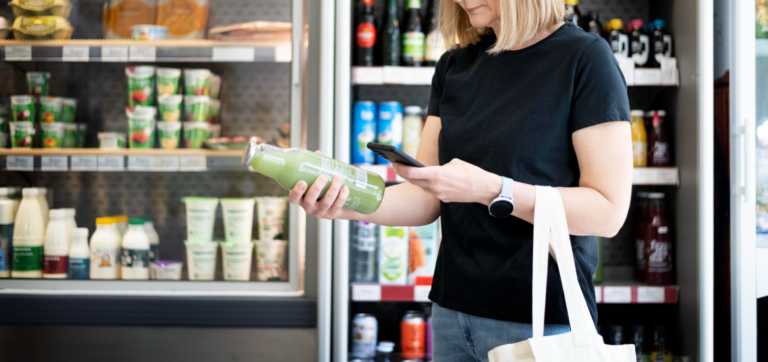The adoption of mobile self-checkout technology has been rapid and widespread. By empowering customers to use their smartphones for scanning and payment, retailers have revolutionized shopping efficiency.
This shift is not just about cutting hardware costs – it is also about elevating the customer experience. Integrated loyalty programs, instant access to product information, and the elimination of traditional checkout lanes are just a few benefits of this technology.
However, the convenience of Scan & Go shopping brings with it a heightened risk of shoplifting. The impersonal nature of self-service systems can inadvertently lower inhibitions, making theft a pressing issue for retailers – who must react quickly. A 2022 study on self-checkout in retail estimated that these systems accounted for 23% of total unknown store losses.
Understanding self-checkout theft: Why customers turn shoplifters
Shoplifting is a complex problem, and meaningfully addressing self-checkout theft requires a deep understanding of its causes.
These causes encompass a range of behaviors and motivations. Some individuals shoplift due to financial distress, while others are driven by the thrill of the act. Yet others feel that their actions are inconsequential against large retail entities.
The design of self-checkout systems, which often lack the human oversight of traditional checkouts, can inadvertently facilitate shoplifting. The absence of a cashier or frustration with malfunctioning equipment can embolden individuals who might not otherwise engage in theft.
This phenomenon, often referred to as “Scan & Go shoplifting,” is a unique challenge for retailers. Among the actual self-checkout theft techniques, the following are particularly common:
- Barcode switching: Physically placing the barcode of a less expensive item onto a more costly one enables individuals to “buy” an expensive product at a lower price.
- Partial scanning or “pass around”: Here, shoppers purposely do not scan all items. They may pretend to scan an item before putting it in the shopping cart, or scan only one item while adding two.
- The “fake swipe” payment trick: This involves a customer pretending to make a payment, typically by simulating the act of swiping.
Tackling the challenge of shoplifting at self-checkout
Combatting self-checkout theft requires a combination of technological innovation and in-store practices. Retailers must carefully weigh their need to prevent losses against the desire to maintain a seamless shopping experience for honest customers. This balance is key in deterring theft while retaining the advantages of self-checkout systems.
How can self-checkout design prevent theft?
The design of self-checkout kiosks itself may inadvertently tempt customers to steal. Some simple measures can increase accountability and prevent regular shoppers from stealing.
- Integrated weight sensors: Items in shopping baskets placed on the bagging area are weighed and cross-checked with the product database. Weight discrepancies trigger alerts or require staff approval. This makes it difficult for customers to skip items when scanning.
- AI-powered camera monitoring: With high-definition cameras at self-checkout registers, AI systems analyze both point-of-sale (POS) data and video feeds to detect suspicious patterns, such as unscanned items.
- Employee oversight stations: Visible employee presence directly addresses a main weakness of self-checkout systems: reduced supervision. This approach not only deters theft, but the employees can also help regular customers that need assistance.
- POS software alerts: Systems instantly notify managers about high-risk transactions or behaviors, such as customers walking away without payment, or basket items not matching the scanned entries.
Top in-store strategies to combat self-checkout theft
In combination with these design changes, retailers must adopt innovative and effective strategies. These strategies must address the unique challenges presented by self-service technologies, combining technological enhancements with employee awareness to prevent Scan & Go shoplifting.
1. Enhanced customer identification
One effective deterrent against self-checkout theft is robust customer identification. By requiring customers to register with personal details such as name, email, and payment information before using mobile self-checkout, retailers can significantly reduce anonymity and thus discourage shoplifting. Retailers could also consider integrating biometric verification for added security.
2. Strategic communication & expectation setting
Clear communication is vital in mitigating the risks of shoplifting at self-checkout. Retailers can leverage their mobile apps to inform customers about the proper use of self-checkout systems and the implications of shoplifting. Regular reminders, such as prompts to verify that all items have been scanned properly, can reinforce honest behavior.
3. Implementing spot checks
A well-planned spot-check system is a significant deterrent to potential shoplifters. Retailers can use data analytics to identify patterns that may indicate suspicious activity and conduct spot checks accordingly.
These checks should be conducted in a manner that is respectful and non-accusatory, ensuring that customers see them as a standard procedure. Customers should not feel like they are actively being suspected of theft.
4. Optimizing software functionality
The user experience of the mobile self-checkout app is crucial in preventing theft. A user-friendly interface that makes scanning and payment easy can reduce customer frustration, which is often a trigger for opportunistic theft.
Retailers must ensure that their self-checkout app can reliably scan any barcode, including those that are small, wrinkled, or otherwise difficult to scan. They must equally prevent unwanted barcode scans – such as accidentally adding background items to the cart.
Prevention and education are key to reducing self-checkout theft
To ensure these strategies are effective, retailers should invest in employee training and customer education. Employees should be well-versed in the features of the self-checkout system and trained to handle suspected shoplifting professionally.
Customer education campaigns can also play a crucial role in reducing theft. By informing customers about the benefits of self-checkout systems and the consequences of shoplifting, retailers can create a safer shopping environment.
Challenges of mobile self-checkout in grocery stores
Mobile Scan & Go poses unique challenges that may frustrate originally honest customers.
When customers scan items, they usually do it in front of shelves filled with other products – and barcodes. Accidental scans of more than one item can happen. Angered customers might justify taking one item for another.
Buying age-restricted products, such as alcohol, can also be a headache. Typically, this requires age verification through an employee, increasing wait times for customers.
Protecting self-checkout systems against theft: Boost your mobile app with advanced barcode scanning software
Retailers have to address these challenges to prevent self-checkout theft. Enhancing their mobile Scan & Go app is the first step towards improving the shopping experience, and thus loyalty.
A few small tweaks to software, hardware, and user guidance already lead to a drastic improvement.#
1. Software
Every component integrated into a Scan & Go app has to perform reliably and accurately. This include the ability to function offline, since network connectivity is a common issue in retail stores.
Barcode scanning is the core feature of any Scan & Go app. A Scan & Go barcode scanner should never scan unwanted barcodes, and always scan wanted ones on the first try – even when they are damaged, tiny, or badly lit.
2. Hardware
Customer smartphones come in varying degrees of quality and with different operating systems. Your Scan & Go app, including the integrated software, has to be compatible with as many devices as possible.
3. User guidance
Clear user guidance and UX design are needed to reliably lead customers through the shopping process. With instructions on how to hold the phone, scanning becomes a breeze even for non-tech-savvy users.
In combination, these improvements can drastically change the shopping experience and prevent customers from frustration-motivated self-checkout theft.
Conclusion
The shift towards self-service retail systems like mobile self-checkout requires retailers to handle the specific challenges of self-checkout theft.
By implementing strategic measures such as enhanced customer identification, clear communication, spot checks, and optimized software, retailers can significantly mitigate the risk of Scan & Go shoplifting. Moreover, a focus on prevention through employee training and customer education is essential.These strategies, when effectively executed, not only deter theft but also enhance the overall shopping experience. This ensures that self-checkout remains a valuable asset for retailers.
Would you like to add reliable Barcode Scanning and ID Scanning technology to your retail app? With the Scanbot SDK, you can build a smooth Scan & Go experience. Our experts are looking forward to discussing your use case. Let’s talk.
What is self-checkout theft?
Self-checkout theft is the act of stealing goods from a retail store using self-service checkout systems. This includes not scanning items intentionally, under-scanning, or exploiting system vulnerabilities to avoid payment. It’s a growing concern in the era of advanced retail technologies like mobile self-checkout.
How common is shoplifting at self-checkout?
Shoplifting at self-checkout is increasingly common. The impersonal nature and lack of human supervision in these systems makes it easier for individuals to commit theft.
What are the main causes of Scan & Go shoplifting?
The main causes of Scan & Go shoplifting include the ease of bypassing traditional cashier oversight, frustrating malfunctions, and the perception that self-service theft is less risky or harmful. Personal causes include financial distress or thrill-seeking.
Are there specific strategies retailers can employ to reduce theft in mobile self-checkout systems?
Retailers can employ several strategies to reduce theft in mobile self-checkout systems, such as implementing robust customer identification, clear and consistent communication about self-checkout use, effective spot checks, and optimizing the functionality of their mobile apps.







